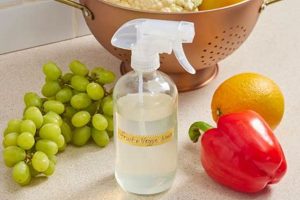A “do it yourself” roach capture device refers to a non-commercial insect trapping method constructed from readily available household materials. These devices are designed to lure and contain cockroaches without the use of professional pest control services or commercially manufactured traps. An example would be a bottle baited with sugar water, designed to allow entry but prevent escape.
The significance of constructing these homemade solutions lies in their cost-effectiveness and accessibility. For individuals facing minor infestations or those seeking a non-toxic approach to pest management, these traps offer a readily available alternative. Historically, resourcefulness in crafting pest control methods has been a common practice, particularly in communities with limited access to commercial products.
The subsequent sections will delve into the specific components, construction methods, and factors that influence the efficacy of such trapping approaches. This exploration will provide practical guidance for individuals seeking to implement these methods in their own environments.
Optimizing a Homemade Roach Capture Device
The following guidance serves to enhance the effectiveness of a self-constructed roach trapping system. Attention to these details can significantly improve capture rates.
Tip 1: Bait Selection. The choice of attractant is crucial. Mixtures of sugar and water, stale beer, or bread soaked in water are effective due to their carbohydrate content. Experimentation with different baits may be necessary to determine local cockroach preferences.
Tip 2: Entry Point Design. The trap’s entry point should be easily accessible, yet difficult for escape. A ramp leading into a container with smooth, vertical sides provides an adequate barrier. Ensure the ramp material provides sufficient grip for entry.
Tip 3: Location Selection. Placement of the trap is critical. Position traps in areas known to harbor cockroaches: under sinks, behind appliances, and in dark, undisturbed spaces. Observe cockroach activity to determine optimal locations.
Tip 4: Trap Hygiene. Regular cleaning of the trap is essential. Remove deceased cockroaches and replenish the bait frequently. A buildup of dead insects can deter subsequent entries and reduce trap effectiveness.
Tip 5: Trap Concealment. Cockroaches prefer dark, secluded environments. Camouflage the trap’s exterior to blend with its surroundings. This can be achieved by covering the trap with dark cloth or placing it within a shadowed area.
Tip 6: Material Selection. Opt for non-porous materials in trap construction to prevent absorption of odors that could repel cockroaches. Glass or smooth plastic containers are preferable to cardboard or porous wood.
Tip 7: Perimeter Sealing. Enhance the trap’s effectiveness by sealing potential alternative food sources. Thoroughly clean kitchen surfaces, seal food containers, and repair leaky pipes to minimize cockroach sustenance outside the trap.
Consistent implementation of these strategies will improve the performance of any self-assembled roach capture device. A methodical approach, coupled with diligent maintenance, can yield significant results.
The subsequent section will address the limitations and potential drawbacks associated with this method, as well as alternative pest management strategies.
1. Bait Attractiveness
Bait attractiveness is a core determinant of success in any “do it yourself” roach trap strategy. The efficacy of a homemade trap is directly proportional to its ability to lure cockroaches from their harborage and into the capture device. A poorly selected or presented bait will render even the most meticulously constructed trap ineffective.
- Nutritional Composition
Cockroaches exhibit preferences for specific nutritional components, primarily carbohydrates, sugars, and starches. Bait formulations that mimic these preferred food sources are more likely to attract cockroaches. Examples include mixtures of sugar and water, molasses, or bread soaked in beer. The precise combination of ingredients may need to be adjusted based on the local cockroach species and their dietary habits.
- Odor Profile
Olfactory cues play a significant role in cockroach foraging behavior. Baits with strong, appealing odors are more likely to draw cockroaches from a distance. The volatile compounds emitted by fermenting fruits or sugary solutions can serve as potent attractants. Consideration should be given to the aging process of baits; over time, the odor profile may shift, affecting its appeal.
- Presentation and Accessibility
The manner in which the bait is presented influences its accessibility to cockroaches. Baits should be positioned in a way that allows easy entry and feeding. For instance, placing a small amount of bait on a shallow dish or sponge provides a readily accessible food source. Obstacles or difficult-to-navigate entry points can deter cockroaches, regardless of the bait’s attractiveness.
- Competition and Satiety
The presence of alternative food sources in the environment can diminish the effectiveness of even the most attractive bait. A cockroach that has access to abundant readily available food may be less inclined to seek out the bait within the trap. Elimination of alternative food sources, such as crumbs, spills, and improperly stored food, is critical for maximizing the impact of the trap.
The elements of nutritional composition, odor profile, presentation, and environmental competition are intertwined in determining bait attractiveness. Optimizing each factor within the constraints of “do it yourself” construction is crucial. Successful implementation of a homemade roach trap hinges on a thorough understanding of cockroach behavior and the careful selection and presentation of an irresistible attractant.
2. Entry Design
Entry design directly influences the efficacy of a “do it yourself” roach trap. The purpose of the entry is to provide easy access for cockroaches while simultaneously preventing their escape. The correlation between the trap’s design and the cockroach’s ability to enter, but not exit, determines the trapping success rate. A poorly designed entry negates the effectiveness of even the most appealing bait, as cockroaches will be unable or unwilling to navigate the access point. For example, a container with excessively steep sides or an overly narrow opening will deter entry, regardless of the lure within.
Practical implementation often involves ramps or funnels leading into a container. Ramps can be constructed from cardboard or other textured materials, ensuring sufficient grip for cockroach ascent. Funnels, frequently fashioned from plastic bottles, narrow the entry point to a size easily traversed by cockroaches, yet too
constricted for an easy upward climb to escape. A critical design element is the smoothness of the interior container walls. Vertical, slippery surfaces hinder the cockroach’s ability to gain purchase and prevent them from climbing out. This principle is frequently employed using petroleum jelly applied to the upper rim of the container as an additional barrier.
In summation, entry design constitutes a crucial element in the effectiveness of homemade roach traps. Balancing ease of access with escape prevention is fundamental to capturing cockroaches. While bait attractiveness draws the insects to the trap, a well-engineered entry ensures their containment. Challenges arise in adapting designs to different cockroach species, given variations in size and climbing ability. Nonetheless, a methodical approach to entry design significantly contributes to the success of “do it yourself” pest control efforts.
3. Trap Placement
Effective “do it yourself” roach trapping is intrinsically linked to strategic trap placement. The efficacy of any homemade roach trap, irrespective of design or bait, is profoundly influenced by its location. Placement dictates the probability of cockroach interaction with the trap, thus directly affecting capture rates. Improper placement renders even the most elaborate and alluring trap ineffective.
Cockroaches are nocturnal creatures that prefer harborage in dark, secluded, and often warm environments. Consequently, successful placement necessitates identification of these areas. High-probability locations include underneath sinks, behind appliances (refrigerators, ovens, dishwashers), inside cabinets, and along baseboards. These areas provide the conditions cockroaches seek: moisture, food debris, and minimal disturbance. For instance, placing a trap in the center of a well-lit room is unlikely to yield results, while situating the same trap behind a refrigerator, where warmth and condensation are present, significantly increases the probability of capture. Understanding cockroach behavior and habitat preferences is crucial for identifying optimal trap locations.
Beyond general habitat preferences, observing cockroach activity patterns can further refine trap placement. Identifying trails or areas with concentrated fecal droppings indicates frequently traversed routes. Positioning traps along these routes maximizes the likelihood of cockroach encounter. Moreover, considering proximity to potential food sources, such as pet food bowls or garbage cans, is essential. While bait within the trap serves as an attractant, cockroaches are more likely to encounter traps located near existing food sources. Careful observation and strategic placement, guided by an understanding of cockroach behavior, are paramount to successful “do it yourself” roach control. The synergistic relationship between trap design and optimal placement significantly enhances the effectiveness of a homemade roach trap, enabling targeted pest management.
4. Material Choice
Material choice is a significant factor in the efficacy and longevity of any “do it yourself” roach trap. The physical properties and chemical composition of the materials used directly influence the trap’s ability to attract, contain, and withstand environmental conditions.
- Surface Properties
The surface texture of the materials selected for trap construction influences cockroach movement and retention. Smooth, non-porous surfaces, such as glass or smooth plastic, hinder the cockroach’s ability to climb out of the trap, effectively preventing escape. Conversely, rough or porous materials, like cardboard or untreated wood, provide a foothold and allow for easier escape. Therefore, the choice of material significantly affects the trap’s ability to retain captured insects. For example, utilizing a smooth-sided glass jar versus a cardboard box as the primary trapping container has a marked impact on retention rates.
- Chemical Inertness
The chemical properties of the materials are crucial to preventing unintended repellency. Materials that are chemically inert, meaning they do not react with the bait or emit volatile organic compounds, are preferred. Certain plastics or treated woods can leach chemicals that repel cockroaches, negating the trap’s purpose. The use of food-grade plastics or glass minimizes this risk. An example includes avoiding certain adhesives or paints that emit strong odors which cockroaches are known to avoid.
- Durability and Resistance
The durability of the selected materials dictates the trap’s lifespan and resilience to environmental factors. Materials resistant to moisture, temperature fluctuations, and physical damage are advantageous. Cardboard, while readily available, degrades quickly in humid environments and is susceptible to damage. Durable plastics or glass offer greater longevity and resistance to wear. In humid environments, a trap constructed from plastic or glass will outlast a cardboard trap, requiring less frequent replacement and maintaining consistent effectiveness.
- Transparency and Light Penetration
The transparency of the chosen material can impact cockroach behavior. Cockroaches generally prefer dark, secluded environments. Opaque or semi-opaque materials provide a more appealing environment for cockroach entry compared to transparent materials that allow light penetration. Utilizing a darkened or covered container, even if made of transparent material, can increase trap attractiveness. For instance, covering a clear plastic container with dark tape or paint can improve capture rates by reducing light exposure inside the trap.
In conclusion, material choice in “do it yourself” roach trap construction extends beyond mere availability. It encompasses considerations of surface properties, chemical inertness, durability, and transparency, each contributing significantly to the overall effectiveness of the trap. Thoughtful selection of materials, considering these factors, maximizes the trap’s attractiveness, longevity, and capacity to effectively capture cockroaches.
5. Maintenance Frequency
Maintenance frequency directly impacts the effectiveness of a “do it yourself” roach trap. Infrequent maintenance diminishes the trap’s appeal and functionality, leading to reduced capture rates. This connection operates on several levels. The bait, the primary attractant, degrades over time, losing its potency. Environmental factors such as humidity can alter the bait’s consistency and odor, making it less attractive or even repellent to cockroaches. For instance, a sugar-water bait left unattended for several days may ferment, changing its scent profile and deterring entry.
Additionally, accumulation of deceased cockroaches within the trap reduces available space and creates an unsanitary environment. This build-up can deter other cockroaches from entering, effectively rendering the trap useless. Consider a scenario where a trap, initially effective, becomes filled with dead insects and debris. The presence of these decaying remains emits unpleasant odors, discouraging subsequent cockroach entries. Regular emptying and cleaning are therefore essential for sustained effectiveness. Furth
ermore, physical damage to the trap, such as cracks or breaches, can compromise its structure and allow captured cockroaches to escape. Periodic inspection and repair are necessary to maintain the trap’s integrity.
In summation, consistent and timely maintenance is not merely a supplementary task but an integral component of a successful “do it yourself” roach control strategy. Neglecting this aspect undermines the effort invested in trap design and placement. A well-maintained trap, with fresh bait and a clean environment, maximizes its attractiveness and trapping efficiency. Regular maintenance also ensures the trap remains structurally sound and continues to function as intended. Therefore, maintenance frequency should be considered a critical factor when evaluating the effectiveness of any homemade roach trap.
6. Environmental Hygiene
Environmental hygiene represents a foundational element in the efficacy of any “do it yourself” roach trap strategy. The level of cleanliness and sanitation within a given environment directly influences the availability of alternative food sources and harborage sites for cockroaches, thus impacting the attractiveness and effectiveness of the deployed trap. Insufficient environmental hygiene diminishes the reliance of cockroaches on the trap’s bait, rendering the homemade trapping solution less potent. For instance, a kitchen with readily available crumbs, spills, and improperly stored food provides cockroaches with ample sustenance, reducing their incentive to seek out the bait within the trap. The trap, in this scenario, becomes merely one of many food sources, diminishing its impact on the overall cockroach population.
Practical application of this understanding involves a multifaceted approach. First, thorough cleaning practices are paramount. This includes regular sweeping, vacuuming, and washing of surfaces to eliminate food debris. Second, proper food storage is crucial; all food items should be stored in airtight containers to prevent cockroach access. Third, diligent waste management practices, such as securing garbage can lids and frequent disposal of refuse, are essential to minimizing food sources. Moreover, addressing water leaks and moisture accumulation is vital, as cockroaches require water for survival. Reducing moisture sources restricts their harborage options and forces them to seek alternative sources, increasing the likelihood of encountering the trap. An example includes repairing leaky pipes and ensuring proper ventilation in damp areas.
In conclusion, environmental hygiene is inextricably linked to the success of “do it yourself” roach control efforts. Its importance cannot be overstated, as it directly influences cockroach behavior and the trap’s ability to attract and capture these pests. By diligently maintaining a clean and sanitary environment, individuals can significantly enhance the effectiveness of homemade roach traps and reduce cockroach populations. This proactive approach, combined with strategic trap placement and maintenance, offers a comprehensive and sustainable solution for managing cockroach infestations. The challenge lies in consistently adhering to stringent hygiene practices, as lapses can negate the benefits of even the most well-designed and maintained trap.
Frequently Asked Questions
The following addresses common inquiries regarding the construction, deployment, and effectiveness of homemade cockroach traps.
Question 1: What materials are best suited for constructing a “do it yourself” roach trap?
Ideal materials are smooth, non-porous, and durable. Glass or rigid plastics are preferred due to their ease of cleaning and resistance to degradation. Avoid absorbent materials like cardboard, as they can harbor bacteria and odors that repel cockroaches.
Question 2: What constitutes an effective bait for a homemade cockroach trap?
Effective baits typically contain carbohydrates and sugars. Mixtures of sugar and water, molasses, or stale beer are frequently used. The specific attractant may need to be tailored to the local cockroach species’ preferences.
Question 3: Where should “do it yourself” roach traps be placed within a dwelling?
Placement should focus on areas with known cockroach activity: under sinks, behind appliances, inside cabinets, and along baseboards. Positioning traps near potential food and water sources maximizes their effectiveness.
Question 4: How frequently should a “do it yourself” roach trap be cleaned and re-baited?
Traps should be cleaned and re-baited at least every 2-3 days. Decaying insects and stale bait can deter other cockroaches. More frequent maintenance may be necessary in heavily infested areas.
Question 5: Are “do it yourself” roach traps a viable alternative to professional pest control services?
Homemade traps can be effective for minor infestations. However, severe or persistent infestations often require professional intervention. “Do it yourself” methods may not address underlying causes or reach hidden cockroach populations.
Question 6: What are the limitations of relying solely on “do it yourself” roach traps for pest management?
Homemade traps typically target foraging cockroaches but do not eliminate the source of the infestation. They may not be effective against all cockroach species or developmental stages. Integrated pest management strategies, including sanitation and habitat modification, are often necessary for long-term control.
In summary, while resourceful and cost-effective, “do it yourself” roach traps represent only one component of a comprehensive pest management approach. Success hinges on diligent maintenance, strategic placement, and a thorough understanding of cockroach behavior.
The subsequent section will address additional strategies to complement these methods, for a complete approach.
DIY Roach Trap
This exploration has detailed the principles underlying effective “diy roach trap” construction and deployment. Key factors include strategic bait selection, optimized entry design, precise trap placement, appropriate material choice, consistent maintenance, and diligent environmental hygiene. Success necessitates a comprehensive understanding of cockroach behavior and a commitment to consistent implementation of these principles.
While “diy roach trap” methods offer a readily accessible and cost-effective approach to pest management, their limitations must be recognized. For persistent or severe infestations, professional pest control services remain a necessity. Long-term success relies not solely on trapping, but on integrated strategies encompassing sanitation, habitat modification, and, when necessary, professional intervention. The pursuit of effective pest management demands both resourcefulness and a realistic assessment of the challenges involved.







